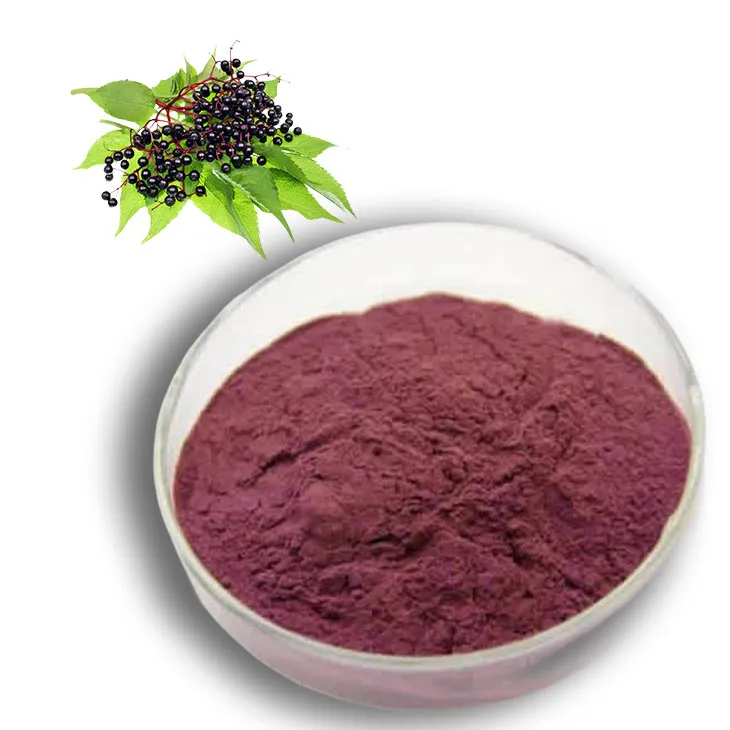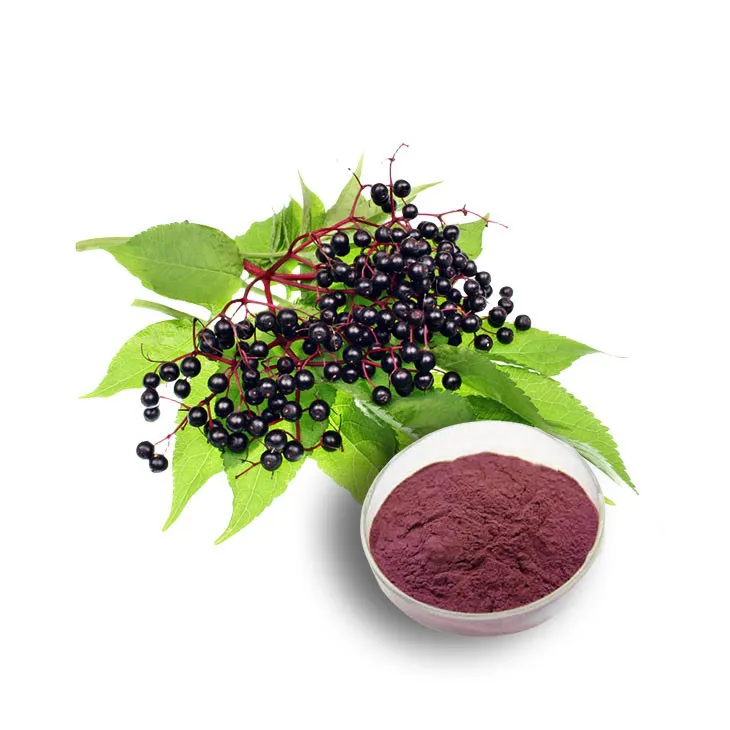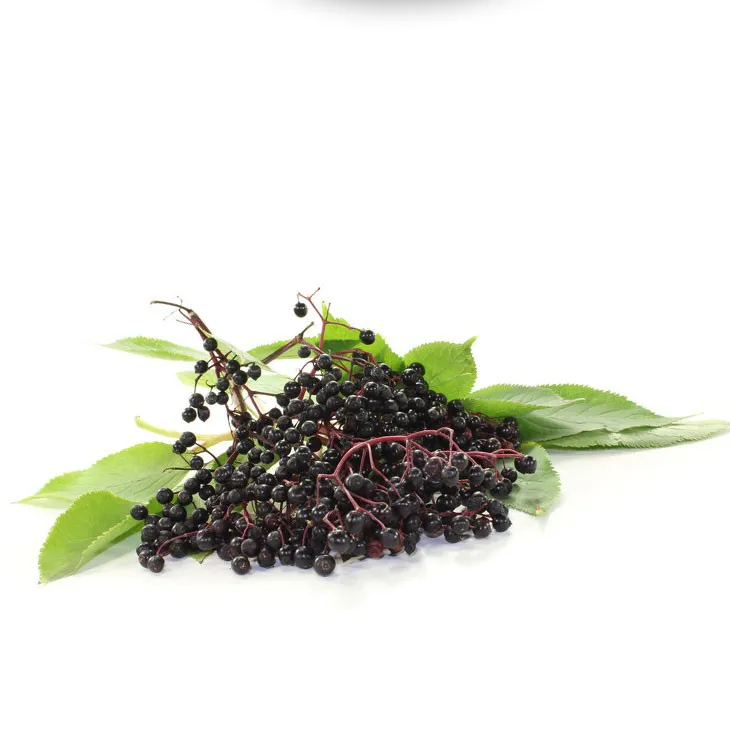- 0086-571-85302990
- sales@greenskybio.com
How to Extract Elderberry Extract by Steam Distillation.
2024-11-27

1. Introduction to Elderberries
Elderberries are small, dark - purple berries that are rich in nutrients and antioxidants. They have been used for centuries in traditional medicine for their various health benefits. The berries are known for their high content of vitamins such as vitamin C, as well as flavonoids and anthocyanins, which are powerful antioxidants. These properties make elderberries a valuable source for extraction, and steam distillation is one of the effective methods to obtain its beneficial compounds.

2. Why Steam Distillation for Elderberry Extract?
2.1 Gentle Extraction Method
Steam distillation is a relatively gentle extraction method. It allows the extraction of volatile compounds from the elderberries without subjecting them to excessive heat or harsh chemicals. This is important because elderberries contain delicate compounds that can be easily damaged by more aggressive extraction techniques. The low - temperature process of steam distillation helps to preserve the integrity of these compounds, ensuring that the resulting extract retains most of its beneficial properties.
2.2 Selective ExtractionSteam distillation can selectively extract certain components from the elderberries. For example, it can isolate the essential oils and some of the volatile antioxidants present in the berries. This selectivity is beneficial as it allows for the concentration of specific compounds that are of particular interest, such as those with strong antioxidant or antimicrobial properties.

3. Equipment Needed for Steam Distillation of Elderberries
3.1 Steam Generator
A reliable steam generator is crucial for the steam distillation process. It should be able to produce a consistent supply of steam at the appropriate pressure. There are various types of steam generators available, ranging from small, laboratory - scale models to larger industrial - sized ones. For home - made or small - scale extraction, a simple electric steam generator can be sufficient.
3.2 Distillation ApparatusThe distillation apparatus typically consists of a still pot, a condenser, and a collection vessel. The still pot is where the elderberries are placed for distillation. It should be made of a material that can withstand heat and is non - reactive with the berries, such as glass or stainless steel. The condenser is used to cool the steam and convert it back into a liquid, and the collection vessel is where the extracted Elderberry Extract is collected.
3.3 ThermometerA thermometer is necessary to monitor the temperature during the distillation process. This helps to ensure that the temperature remains within the optimal range for the extraction of the desired compounds. A digital thermometer with high accuracy is recommended for better control.

4. Preparation of Elderberries for Steam Distillation
4.1 Harvesting
Elderberries should be harvested at the right time. They are typically ready for harvest in late summer or early fall. When harvesting, it is important to choose ripe berries that are fully colored and plump. Avoid berries that are under - ripe or over - ripe as they may not yield the best results. Additionally, make sure to harvest from clean, unpolluted sources to ensure the quality of the extract.
4.2 CleaningOnce harvested, the elderberries need to be thoroughly cleaned. Remove any stems, leaves, or debris that may be attached to the berries. Wash the berries gently in cold water to remove dirt and any surface contaminants. However, be careful not to soak the berries for too long as this may cause the loss of some water - soluble compounds.
4.3 CrushingAfter cleaning, the elderberries can be crushed. Crushing helps to break open the berries and expose more of their internal surfaces to the steam during distillation. This can increase the efficiency of the extraction process. The berries can be crushed using a mortar and pestle or a mechanical crusher. However, do not crush them too finely as this may cause clogging in the distillation apparatus.
5. The Steam Distillation Process
5.1 Loading the Still Pot
Place the crushed elderberries into the still pot. Do not overfill the pot; leave some space at the top to allow for proper steam circulation. Typically, filling the pot about two - thirds full is a good rule of thumb.
5.2 Starting the Steam GeneratorTurn on the steam generator and adjust the settings to produce a steady stream of steam. The steam should be introduced into the still pot at a controlled rate. The pressure of the steam should also be monitored to ensure that it is within the appropriate range for the distillation of elderberries.
5.3 Distillation and CondensationAs the steam passes through the elderberries in the still pot, it will carry the volatile compounds with it. The steam - laden with these compounds then enters the condenser. In the condenser, the steam is cooled down, usually by running cold water around the condenser coils. This causes the steam to condense back into a liquid, which then drips into the collection vessel.
5.4 Monitoring the ProcessThroughout the distillation process, continuously monitor the temperature using the thermometer. Also, keep an eye on the steam flow and the amount of extract being collected in the collection vessel. If any irregularities are noticed, such as a sudden drop in steam pressure or a significant change in temperature, take appropriate actions to correct the situation.
6. Safety Precautions during Steam Distillation of Elderberries
6.1 Heat - related Hazards
Steam distillation involves the use of heat, and there is a risk of burns. Always wear heat - resistant gloves when handling hot equipment such as the still pot or the condenser. Also, make sure that the distillation apparatus is placed on a stable and heat - resistant surface to prevent accidental tipping or damage due to heat.
6.2 Pressure - related HazardsSince steam is used, there can be pressure - related hazards. The steam generator should be properly maintained and operated within its specified pressure limits. Regularly check the pressure valves and gauges to ensure that they are functioning correctly. In case of any abnormal pressure build - up, have a safety release mechanism in place to prevent explosions.
6.3 Chemical ExposureAlthough elderberries are generally safe, during the distillation process, some volatile compounds may be released. These compounds may be irritating to the eyes, nose, or skin. Wear appropriate safety goggles, a face mask, and protective clothing to minimize the risk of chemical exposure. Also, make sure that the distillation area is well - ventilated to disperse any potentially harmful vapors.
7. Optimizing the Extraction Yield
7.1 Particle Size of Elderberries
The particle size of the crushed elderberries can affect the extraction yield. A proper balance needs to be struck between having a large enough surface area for efficient extraction and not having particles that are too fine. If the particles are too large, the steam may not be able to penetrate effectively, reducing the yield. On the other hand, if the particles are too fine, they may clog the distillation apparatus. Experiment with different particle sizes to find the optimal one for maximum extraction yield.
7.2 Steam Flow RateThe steam flow rate is another important factor. A too - slow steam flow rate may not carry all the volatile compounds out of the elderberries efficiently, resulting in a lower yield. However, a too - fast steam flow rate may cause some of the compounds to be carried away without proper condensation, also reducing the yield. Adjust the steam flow rate during the distillation process to find the optimal speed for maximum extraction.
7.3 Distillation TimeThe length of the distillation time can impact the extraction yield. If the distillation time is too short, not all the desirable compounds may be extracted. Conversely, if the distillation time is too long, it may lead to the extraction of unwanted compounds or the degradation of some of the beneficial ones. Conduct trials to determine the optimal distillation time for elderberries based on the equipment used and the desired extract quality.
8. Conclusion
Steam distillation is an effective method for extracting Elderberry Extract. By understanding the properties of elderberries, having the right equipment, following proper preparation and distillation procedures, taking safety precautions, and optimizing the extraction yield, one can obtain a high - quality elderberry extract rich in antioxidants and other beneficial compounds. This extract can then be used in various applications, such as in the production of natural health products, cosmetics, or as a flavoring agent in the food industry.
FAQ:
What are the main properties of elderberries for steam distillation?
Elderberries contain various volatile compounds that can be effectively extracted through steam distillation. They are rich in antioxidants, flavonoids, and other bioactive substances. These components have different boiling points and solubilities, which is important for the steam distillation process. The structure of the elderberry allows the steam to penetrate and carry out the volatile substances during distillation.
What safety precautions are necessary during the steam distillation of elderberries?
Firstly, proper protective equipment such as heat - resistant gloves and goggles should be worn. The distillation apparatus needs to be checked for leaks before starting the process to avoid steam burns or exposure to harmful substances. When handling the hot distillation equipment, use appropriate tools to prevent direct contact. Also, ensure good ventilation in the working area as some volatile components released during distillation may be irritating or harmful if inhaled in large quantities.
How can we optimize the extraction yield of elderberry extract by steam distillation?
One way is to ensure the proper grinding of elderberries before distillation. Finely ground berries have a larger surface area, which allows for better interaction with the steam. Adjusting the steam flow rate is also crucial. A moderate steam flow can ensure efficient extraction without causing excessive turbulence or incomplete extraction. Additionally, maintaining a consistent temperature throughout the distillation process can help to maximize the yield. Repeating the distillation process in a controlled manner may also increase the overall extraction yield.
What equipment is required for steam distilling elderberries?
Typical equipment includes a distillation flask to hold the elderberries, a condenser to cool the steam and convert it back to liquid, a heat source such as a heating mantle or a Bunsen burner, a receiving flask to collect the distilled extract, and tubing to connect the different components. A thermometer is also necessary to monitor the temperature during the distillation process.
How long does the steam distillation of elderberries usually take?
The duration of steam distillation of elderberries can vary depending on several factors. Generally, it can take anywhere from 2 - 6 hours. The factors affecting the time include the amount of elderberries used, the fineness of the grind, the steam flow rate, and the efficiency of the distillation equipment. A larger quantity of berries or a coarser grind may require a longer distillation time.
Related literature
- Steam Distillation of Bioactive Compounds from Elderberries: A Comprehensive Review"
- "Optimizing Elderberry Extract Production through Steam Distillation: Recent Advances"
- "Safety Considerations in Elderberry Steam Distillation: A Practical Guide"
- ▶ Hesperidin
- ▶ citrus bioflavonoids
- ▶ plant extract
- ▶ lycopene
- ▶ Diosmin
- ▶ Grape seed extract
- ▶ Sea buckthorn Juice Powder
- ▶ Beetroot powder
- ▶ Hops Extract
- ▶ Artichoke Extract
- ▶ Reishi mushroom extract
- ▶ Astaxanthin
- ▶ Green Tea Extract
- ▶ Curcumin Extract
- ▶ Horse Chestnut Extract
- ▶ Other Problems
- ▶ Boswellia Serrata Extract
- ▶ Resveratrol Extract
- ▶ Marigold Extract
- ▶ Grape Leaf Extract
- ▶ blog3
- ▶ blog4
-
Kudzu root extract suppliers.
2024-11-27
-
The Most Well - received Vitamin B9 Powder.
2024-11-27
-
Suppliers of Organic β - Carotene Powder.
2024-11-27
-
100% Pure Organic Black Garlic Extract.
2024-11-27
-
The best - quality astaxanthin.
2024-11-27
-
Lycopene
2024-11-27
-
Tinospora cordifolia extract
2024-11-27
-
Baicalin
2024-11-27
-
Hedyotis Diffusa Extract
2024-11-27
-
Nettle Root Extract
2024-11-27
-
Green Tea Extract
2024-11-27
-
Senna Leaf Extract
2024-11-27
-
Tormentil Extract
2024-11-27
-
Hops Extract
2024-11-27
-
Natural grape seed extract
2024-11-27





















